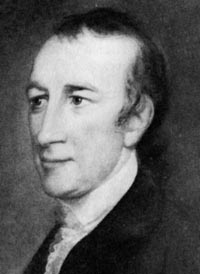
Thomas Stone, signer of the Declaration of Independence | Public domain image.
Not as vocal as his compatriots, Thomas Stone is one of the lesser known signers of the Declaration of Independence. He served his country when called to do so, but preferred a quiet life with family over a life in the limelight.
Thomas Stone was born in 1743 in Charles County, Maryland. He loved learning, even as a boy, and, as the story goes, rode 10 miles on horseback every day to attend school. Like so many of his contemporaries, after his primary education, he pursued the law, studying under Thomas Johnson, Maryland’s first state governor.
In 1764, he was accepted into the foo of Maryland and set up his own practice, which was moderately successful. In 1768, he married Margaret Brown. The pair were extremely happy together; they bought a farm and had three children. Over time, Stone’s law practice grew, and he built a reputation for promoting anti-British policies.
In 1774, Thomas Stone was elected to the Continental Congress, and was re-elected several years in a row. He was not as vocal as some of the other Congressmen, but we do know that he was was pro-independence, even though he supported reconciliatory measures to begin with and the State of Maryland limited his ability to vote for extreme patriotic measures.
The Maryland legislature was cautious of the rebellious spirit which had invaded Boston and ordered the delegates of their state not to vote for independence without the prior approval of the state. Therefore, Stone and the other Maryland signers, Samuel Chase and William Paca, frustrated some of the Congressmen who were very strongly in favor of separation from England. When, however, it appeared that separation was the only choice, Maryland gave the go ahead, and the Maryland delegates voted in favor of independence. They all signed the Declaration of Independence, but Thomas Stone hoped that America would peacefully resolve things with England, as he was a pacifist and hoped to avoid loss of life.
Thomas Stone was elected to be on the committee drafting the Articles of Confederation. During this time, his wife came to visit him in Philadelphia. Smallpox was running rampant through the colonies, so Thomas had Margaret inoculated. It affected her poorly. She grew very sick; and though she initially recovered, her health was never the same. She continued to decline over the years.
After signing the Declaration, Thomas took Margaret home, and didn’t take further part in the Congress at Philadelphia, only attending a few meetings when Congress met in Annapolis in 1784. When the Maryland legislature began to question whether they’d made a mistake joining the confederacy, Stone joined the Maryland legislature in order to help win them over. He helped explain the Articles until Maryland agreed to sign them.
Thomas Stone was elected to the Maryland Senate in 1779, and served until 1785, when he withdrew from his law practice and all public life to care for his wife and children. Thomas was invited to attend the Constitutional Convention, but declined. In 1787, Margaret died, leaving him heartbroken.
Stone never recovered from his grief. Four months after Margaret’s death, his physician recommended a sea voyage to cheer him up, and it was at a shipyard in Alexandria, VA where Thomas Stone, waiting for his ship, died suddenly of his grief at 44 years old.


